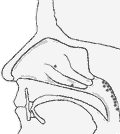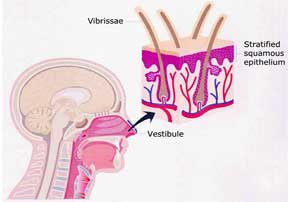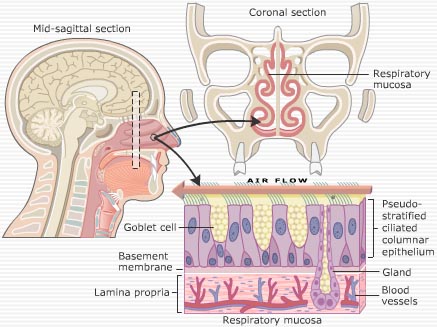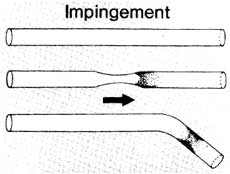The Main Roles of the Turbinates
- To direct and maintain laminar airflow, respiratory rate and velocity
- Air Conditioning (Humidification + Heating)
- Filtration
- Olfaction
Filtration
Through organizing the pattern of airflow by the turbinates, the nose manages to get all the inspired air to stream relatively slowly around and along the heavily ciliated turbinates, emitting heat and humidity into the inspired air streams, saturating the inspired air-born particles and micro-organisms, hence making them heavier and causing them to sink onto the mucosal layer, where they are processed by different immune systems cells, and enzymes, neutralized, and propelled by the beating of the cilia towards the naso-pharynx and the esophagus.
Nearly all particles greater than 5 µm and about 50 % of those from 2-4 µm in size are deposited on the ciliated mucosa, and are propelled towards the pharynx so that they can be swallowed or expectorated within 15 minutes. Particles less than 2 µm pass through the nose into the lower airways.
Fig 33: Animation of filtration. Notice impingement point at nasopharynx. Particles neutralized by secretion of the adenoide, located exactly there.
The inspired air is cleaned by four mechanisms: impingement, electrostatic charge, vibrissae, and cilia and mucus.

Fig 33: Animation of filtration. Notice impingement point at nasopharynx. Particles neutralized by secretion of the adenoide, located exactly there.
Impingement:
Impingement is the phenomenon by which particles suspended in the gas are deposited on the walls of the tube downstream from a bend or constriction in the tube. There are two such bends in the nasal air-stream (Fig 12): at the nasal valve where the air-stream is changed from a column into a sheet, and at the posterior nasopharynx where it is directed downward. Eighty-five to 90% of particulate matter 5– 6 µm or greater are removed at these two impingement points.
Electrostatic Charge:
Electrostatic Charges of foreign particles attract them to the nasal walls.
Vibrissae:
Large particles are caught in the Vibrissae hairs, that are located in the frontal nares.
|
Fig 34: a demonstration of impingement in a tube. Particles deposited downstream from a constriction or bend. |
Fig 35: Electrostatic attraction of foreign particles to nasal wall. |

Fig 36: Vestibule tissue with vibrissae.
Cilia and Mucus
The mucus blanket is a thin, sticky, tenacious adhesive sheet with a pH of serum or slightly lower. It is produced by the serous and mucous glands and by the goblet cells of the mucosa. The lumina of the paranasal sinuses are relatively unexposed to noxious elements and may provide a source of “un-contaminated” mucus to dilute irritants that might be ciliostatic to the cilia layer. Two layers of the mucous blanket have been identified: the deeper is a thinner, less viscid periciliary layer, and the more superficial layer is a thicker and more viscid layer into which the tips of the cilia penetrate when fully extended.

Fig 37: Illustration of filtration and air-conditioning.

